Table of Contents
- What Is a Large Community Wind Project?
- Identify the Motivation for the Project
- Engage with the Community
- Conduct a Feasibility Study
- Conduct Siting Due Diligence
- Assess Your Wind Resource
- Plan Interconnection
- Secure Power Purchase Agreements
- Understand Ordinances, Zoning, & Permitting
- Select & Procure a Turbine
- Understand the Construction Process
- Understand Operations & Maintenance
- Learn About Project Economics & Tools
- Research Financing Options
- Know the Effects of Policies & Incentives
- References
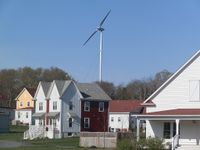
The Sandywoods community in Rhode Island features a community wind project. Photo from Stefan Dominioni, NREL 26490
Community wind projects are locally owned developments consisting of turbines that can vary in number, type, and size. Historically, these projects have been utilized to supply local electricity for a variety of applications, including schools, hospitals, businesses, farms, ranches, or community facilities. Rural electric cooperatives or municipal utilities have also developed their own community wind projects to diversify electricity supplies. Community wind owners may also be local individuals who form independent power producer groups or limited liability corporations to sell the power the turbines produce to a local electricity supplier.[1]
Locally owned community wind projects create even more of an economic opportunity for those involved than conventional wind farms owned by companies with limited local ties. Compared to conventional wind power projects, community wind projects have a greater impact in terms of economic benefits because of two key factors: the project being locally owned and overall project profitability. Research indicates that "construction-period employment impacts are 1.1 to 1.3 times higher and operations-period impacts are 1.1 to 2.8 times higher for community wind versus conventional wind power projects."[2] The level of increased economic benefits is determined by the availability and use of local, qualified labor and supplies, as well as the ownership structure and financing details.[1]
Why Community Wind Projects?
Because community wind projects are locally owned, residents can influence the siting and sizing of projects and ensure that local interests are honored.[1] The local community can develop guidelines for establishing local ordinances, ensuring that future projects will follow regulations established for setbacks, sound levels, and aesthetics of future wind projects.
With the combination of no fuel costs and relatively low operating costs, owners of community wind projects can confidently predict the price that they will pay for energy throughout the lifetime of the project.[1] Community wind projects produce energy that can be used directly or sold to local utilities at a fixed rate through a power purchase agreement, providing long-term energy price stabilization. In areas where importing fuel results in high electricity costs, developing community wind projects can stabilize or lower energy costs.
Plans for siting new energy projects in a community—whether oil and gas wells, nuclear power plants, solar farms, or wind farms—are often met with opposition. Community wind projects garner high levels of support from people living in nearby communities. Increased local acceptance and public support may result from the involvement of local residents as investors or shareholders in these developments.[3][4][5][6] The variety of different applications for which community wind projects can be used may also be a factor in garnering support for the project from local residents.
Community wind projects generally operate on a smaller scale than utility-scale wind farms, so they may not require transmission upgrades. Most community wind projects can be easily connected to the distribution grid.[1]
Electricity production from wind turbines does not pollute the water we drink or the air we breathe. Wind energy reduces health care and environmental costs associated with air pollution. Also, wind energy requires no mining, drilling, or transportation of fuel and it poses no risk of large-scale environmental contamination.[1]
A majority of community wind projects are located in rural areas where water conservation is a serious concern. Community wind energy can become part of the solution when examining energy production and potential water savings. Wind energy requires minimal amounts of water, whereas thermal generators are among the largest consumers of water in the United States.[1] By diversifying the local energy supply, communities can help manage the water supply risks on a local level.
This handbook was designed to provide guidance for the siting and development activities required to develop a large wind project ($2 million+) in your community. For small wind projects ($10,000 – $100,000), see the Small Community Wind Handbook. Following the steps outlined in this handbook will help with the development of a successful project.
What Is a Large Community Wind Project?
A community wind project features a significant level of local control and ownership. A large community wind project is defined in this handbook as a community wind project with one or more utility-scale wind turbines (i.e., a turbine with a rated power of 1,500 kilowatts [kW] or more).
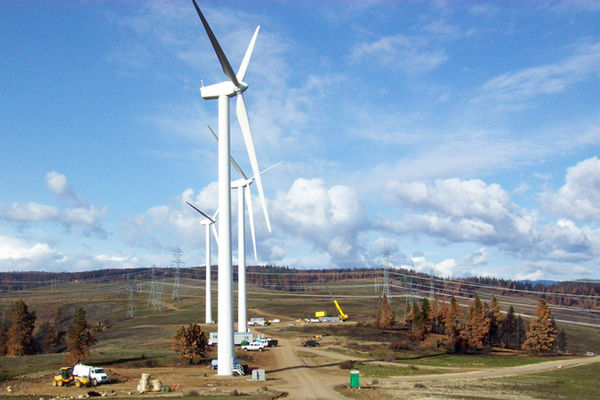
Turbines at Swauk Creek Ranch generate community-scale power. Photo from McKinstry, NREL 26780.
Projects of this size have an installed cost of more than $2 million and allow homeowners, businesses, schools, municipalities, and other organizations to independently produce enough energy to meet most or all of their energy needs.
The capacity-weighted average installed cost within a sample of 2021 projects stood at $1,500/kW. Installed costs have largely held steady over the past 4 years. [7]
Identify the Motivation for the Project
Defining the motivation for your large community wind project is an important first step that will provide a foundation to build on.
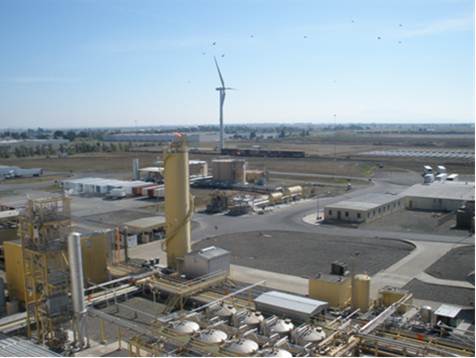
A 1.5-MW GE wind turbine at Anheuser-Busch in Fairfield, California, provide 25% of facility's load. Photo from Foundation Windpower, NREL 26500.
The National Renewable Energy Laboratory's (NREL) 2013 report A Framework for Project Development in the Renewable Energy Sector identified five essential areas for strong project motivation. This section summarizes the framework established in that report to help you identify and define the motivation behind your large community wind project.
Baseline. What are the fundamental reason(s) for the project? Projects can have multiple purposes (monetary gain, environmental message, energy production, energy independence, etc.). An objective analysis of your investment objectives, current energy supply situation, and a clear statement of other project goals should help develop this baseline.
Economics. Will this project be a sound investment? If the motivation for the project is investment driven, conducting an analysis of energy economics (total costs of acquiring energy from existing sources versus costs of proposed project) is an important step. Understanding the risk profile associated with each economic driver and the return on investment (ROI) of competing alternative investments (e.g., a 401K) can also help answer this question.
Policy. Do current policies support a large community wind project? An early examination of federal, state, and local regulatory practices can help define policy incentives and barriers prior to investing significant time or money pursuing a project. Identifying favorable and unfavorable policies early in the process can help determine whether further mitigation, removal, or compromise will be needed later in the development of your wind project.
Technology. Which technology will best fit your large community wind project? Establishing a portfolio that contains preliminary wind resource information for your site will help in determining which wind turbine technology is best suited for your location. Many wind energy systems are available, and it is important to differentiate between reliable technologies and "non-bankable" or unrealistic early-stage technologies so that project stakeholders can make informed decisions.
Consensus. Do stakeholders agree with the proposed project? Reaching team consensus regarding the fundamentals of your large community wind project is a vital step necessary for project success. Achieving this level of agreement involves the input, investment, and possible compromise of project stakeholders. Without this effort, precious resources may not be made available, and involved parties may become project adversaries before construction begins.[8]
Engage with the Community
To decrease early-stage development risk and avoid significant investment in a project that may not be developed due to local concerns, the community should be engaged during the earliest development stages. This activity will allow you to:
- Qualify the local interest and potential opposition pertaining to your large community wind project
- Provide the framework for engagement efforts during the lifetime of the project
- Explain the development in your terms instead of allowing outside communications to introduce your large community wind project
- Develop a list of contacts and identify potential project supporters who can attend public hearings associated with the permitting process.[9]
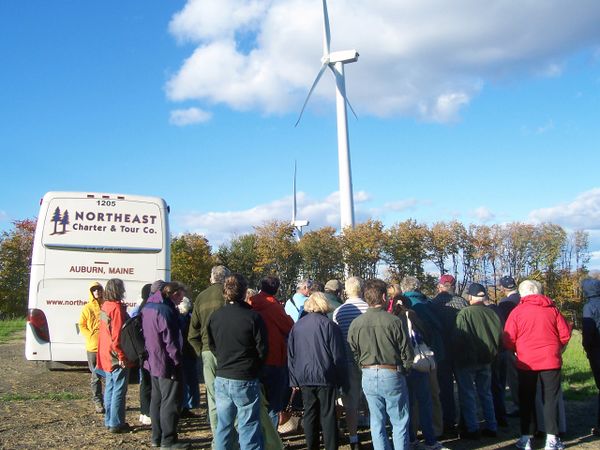
Tours of existing facilities can benefit community engagement. Photo from Skip Babineau, NREL 15334.
Successful community engagement efforts can include consultation activities (public meetings and workshops), pre- and post-development surveys, press releases, media communications, website updates, and a variety of other activities.[10]
Ensure that project- and technology-related information is fact based and robust to provide local officials and the community an accurate portrayal of your large community wind project and its potential impacts.[11]
Remember that community engagement involves listening and responding to those who may have questions or concerns regarding the project. Replying to these inquiries in a timely, respectful, and accurate fashion is vital to building trust within the community.[9]
Conduct a Feasibility Study
A project feasibility study that includes a fatal-flaw analysis should be conducted during the project's preliminary development stage. Fatal flaws must be identified and analyzed in a timely manner to avoid investing capital into projects that are not viable.[12] Whether performed by you or a third party, this study will also help you to better understand current market dynamics pertaining to your project and contribute to the development of a comprehensive business plan.
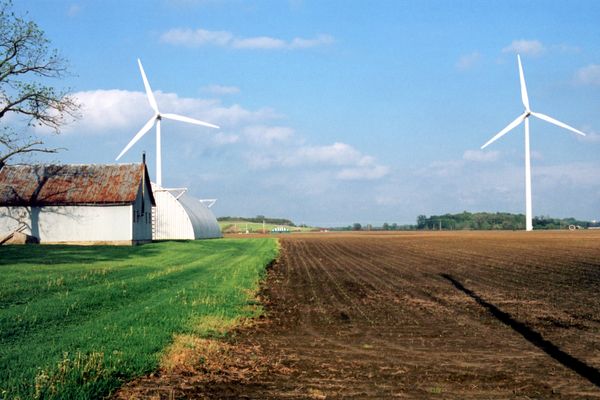
Four 1.8-MB VEstas V80s owned by American Municipal Power-Ohio in Bowling Green, Ohio. Photo from Ohio Office of Energy Efficiency, NREL 14070.
A feasibility study typically includes:
- Project description
- Project goals
- Current and future market potential
- Wind resource assessment
- Realistic permitting process overview
- Equipment procurement plan
- Installation plan (construction and operation support/labor)
- Project details (technical characteristics and specifications)
- Development plan and schedule
- Investment requirements and schedule
- Power marketing plan and revenue schedule
- Projected cost of operation and net revenue
- Economic feasibility study
- Financing plan
- Appendices and notes
- Project management requirements.[13][14]
Conduct Siting Due Diligence
A successful large community wind project requires an ideal location to site the project. In this handbook, siting is divided into two categories: preliminary and late-stage.
Preliminary Siting
Preliminary siting allows for immediate site-related concerns to be addressed prior to large monetary or time investments. The preferred site for a large community wind project offers large parcels of open land with a strong wind resource. If your location meets this minimum requirement, further research of the project site can begin.
Since wind energy projects can be sited on 10 to 80 acres per megawatt (MW) of installed capacity,[15] an understanding of the land use and ownership of your development's location is an important step. Large community wind projects can be sited on land owned by multiple individuals; thus it is vital to engage surrounding property owners to determine general attitudes regarding wind energy, whether or not they would like to be involved in the project, as well as current and planned use of the property.
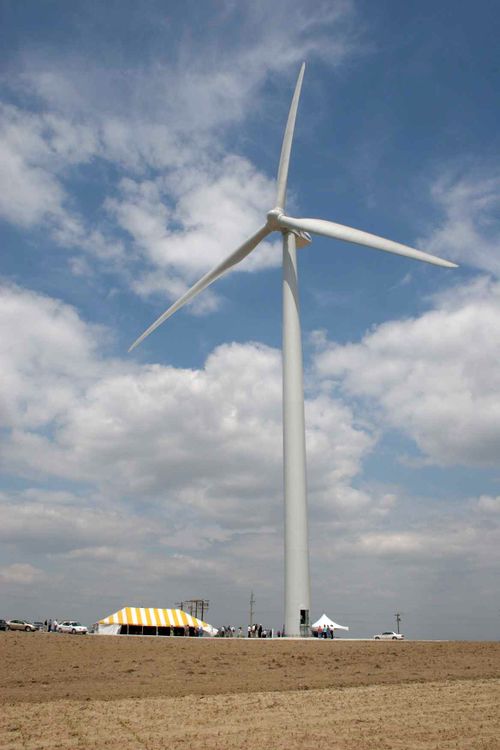
Illinois Rural Electric Cooperative (IREC) is the owner and power purchaser of this 1.65-MW Vestas turbine in Pike County, Illinois. Photo from Illinois Rural Electric Coop., NREL 14377.
Land lease payments (a.k.a. royalty payments, operational payments, or land use fees) can be one of the largest operations and maintenance costs in a project's operational pro forma.[16] It is important to understand the concerns related to securing land leases based on what the project can afford to pay while providing investors an attractive return on investment. Securing these land rights will require time and effort, and it is important to enlist legal guidance to ensure that state and local laws are followed and that the property owners' rights are respected throughout the process. Attorneys will also ensure that land agreements provide sufficient rights to permit the development, construction, operations and maintenance, and decommissioning of your large community wind project.[17]
An additional concern regarding a potential location is whether the land is owned by a private individual or the state or federal government. In general, private ownership tends to simplify the overall permitting process. If any part of your project is connected to federal land (including the point of interconnection, the transmission line, or substation), the National Environmental Policy Act (NEPA) becomes applicable, which can extend the project schedule and increase costs.[18]
Preliminary siting should also include determining access to transmission for your large community wind project. Noting which landowners control land between the proposed site and point of interconnection should be a priority in the land leasing process.
Connecting to an existing substation could provide significant savings since the installation of new transmission lines can be expensive and requires additional utility cooperation;[19] therefore, locations with nearby transmission access are considered beneficial to a large community wind project's overall success. It should be noted that the cost of transmission lines typically increases as the voltage capacity increases (lower voltage typically equals lower cost).[20] Smaller community wind projects can typically use lower-voltage transmission lines, which can equate to overall cost savings.
Late-Stage Siting
Late-stage siting should be conducted once the resource has been assessed and the project is deemed feasible. Late-stage siting includes site-specific characteristics regarding access, terrain, slope, vegetation, soil conditions, etc.
- Project developers should avoid steep slopes that are difficult to build on and can increase project costs. Slopes may have turbulent winds that can impact wind turbines over time.[19]
- Turbines should be sited at a distance 20 or more times the height of surrounding structures or vegetation upwind of the installation. There must be enough room at the site to accommodate suggested distances between turbines and potential obstructions.[19]
- An initial evaluation of the soil conditions in the area can be conducted by reviewing published data such as geology maps, soil survey maps, highway department records, and other reports, studies, and maps. This evaluation can help inform decisions regarding the foundations for the project.[21]
- After the initial evaluation, a geotechnical engineer can conduct a desktop evaluation to determine whether geologic hazards (sinkholes, swelling soils, collapsing soils, underground mining, surface mining, surface spoils from mining, landslides, earthquake issues, volcanic activity, etc.) are prevalent at the site since they can impact wind turbine foundations.[21]
- A soil analysis conducted by a geotechnical engineer will help finalize the foundation design needed for the turbines used in your large community wind project.[21]
- Public roads leading to the project and site access roads are key to transporting equipment and constructing a wind project. Interconnections that allow a wide turning radius are required, and site access roads might need to be improved prior to project installation or may need to be repaired after project completion. Site access roads with suitable grading to allow crane access will also be required for each turbine site.[19]
- If access roads are already available to get components to the installation sites, this could be a benefit because there will be no additional costs. If no access roads are available, they must be built and maintained for the life of the project.
Additional Information
The compilation of project-specific data into a Geographic Information System (GIS) should begin early in the development process. The information collected will include elements from early project development, including early and late-stage siting.
A relatively simple GIS analysis technique involves combining data layers to summarize spatial information. According to the New York State Energy Research and Development Authority and WINDExchange, the following information should be collected for a GIS analysis:
- Wind resource maps
- Land ownership maps (plat maps)
- Terrain data
- Project boundaries
- Water bodies
- Roads and paths
- Land cover data
- Land use data
- Proposed and existing transmission line and substation locations
- Buildings
- Pipelines
- Competing wind projects
- Exclusions
- Permitting requirements
- Radar and airspace restrictions.[22]
Assess Your Wind Resource
The wind resource at the selected site needs to be characterized and understood at a level of detail and confidence appropriate to the project's development stage.[23] Preliminary resource assessment can be conducted early in the development process to validate the investment of time and money for an onsite measurement campaign. While an onsite measurement campaign may be started relatively early in the development process, it is referred to as late-stage resource assessment in this handbook.
Preliminary Assessment
As an initial step, state and regional wind maps or other forms of modeled wind data can be used to estimate the resource in your region. WINDExchange offers a variety of wind maps, including 80-meter high-resolution maps. They are a starting point for large community wind project resource assessments due to their high level and coarse resolution.
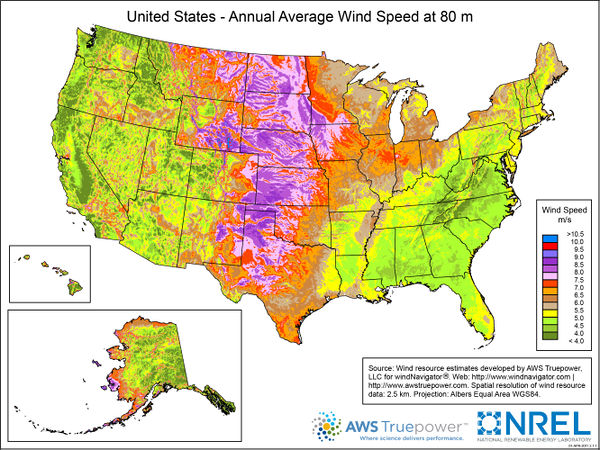
The U.S. Department of Energy provides an 80-meter (m) height, high-resolution wind resource map for the United States with links to state wind maps.
If it's possible to invest capital in a higher-resolution wind map, there are a variety of outlets from which to choose.
There are pros and cons associated with state and regional wind maps as they may be accurate for locations with relatively simple terrain (e.g., no trees or other obstructions) and areas with ample validation data, but they can be less accurate for areas with complex terrain and little data. Although state and regional wind maps are useful, they are not accurate enough to replace onsite measurements (see below for more on this topic).[24]
Large-scale computer weather forecasting is an additional form of modeled wind data that can be used as part of a resource assessment. These models are based on historical data and are designed to predict wind conditions at a specific site. Forecasts of a site's wind resource can be less expensive than conducting onsite data collection for a year or more, but measured, on-site wind data assessments are generally considered to be the most reliable way to evaluate a site's wind resource.[25]
Site-specific data collection confirms the modeled data provided by wind maps and publicly available wind data from nearby locations. Note that publicly available data could have been collected at heights different from your planned turbine's hub height.
If your preliminary site assessment indicates a strong wind resource, you have considered the preliminary siting characteristics (including land ownership profile and interest), and you want to move forward with a large community wind project, the next step is to conduct a thorough resource assessment. Understanding the wind resource of your site is critical because it will determine whether it is worth your time and effort to move forward with the project.
Late-Stage Assessment
Because the investment for a large community wind project is substantial and most likely will involve some form of outside funding (e.g., bank loan, investors), it is critical to ensure that your resource assessment is thorough and uses industry best practices. Measured wind data assessments can be conducted using one of three methods: installing anemometers on meteorological towers ("met" towers), using Sonic Detection and Ranging (SODAR), or using Light Detection and Ranging (LIDAR).
Anemometer Towers
One method of assessing wind resources involves installing anemometers on "met" (meteorological) towers. The number of met towers depends on the complexity of the terrain and the size of the wind project. Most community wind projects involve only one or two turbines, so one met tower should suffice.
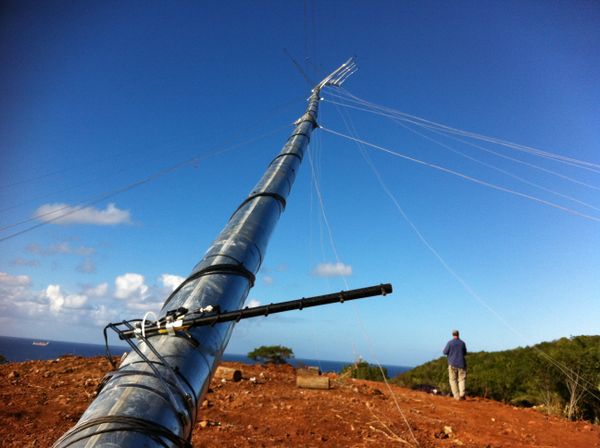
Anemometers are utilized to accurately measure wind speeds at proposed sites. Photo by Owen Roberts, NREL 23842.
The ideal approach to equipping this type of monitoring system is to install anemometers at various heights corresponding to the entire swept area of the rotor at hub height, one at the lowest height the tip of the blade reaches and another at the highest point that the tip reaches. However, due to the high tip heights of utility-scale turbines, it is often impractical to install a met tower this high.[25]
Towers between 50 and 60 meters can be equipped with as many as three anemometers (though two can be used in a minimal equipment scenario) to measure the wind resource for your community wind project. Taller towers (80 meters) can be equipped with as many as four anemometers if a developer determines it is necessary.[24]
Your met tower should also be equipped with a calibrated wind vane located on a boom at the same height as the main anemometer and a data logger housed in a waterproof case and located at the base of the tower.[26] Additional equipment can include a temperature and pressure gauge located at a lower height than the anemometer and supplemental wind vanes and anemometers to ensure accuracy.
Costs associated with the purchase, installation, and 2-year operation of a 50-meter to 60-meter tower plus equipment is between $50,000 and $70,000. The costs increase substantially if you select an 80-meter tower, to $170,000 to $190,000.[24]
SODAR and LIDAR
As the cost of remote sensing devices decreases and the technology's accuracy and reliability improve, SODAR and LIDAR could be used as alternatives to traditional met towers. These two methods are capable of measuring wind characteristics above anemometer tower heights. [24]
Validate the Wind Resource Assessment Data
Data from the wind resource assessment will need to be validated during the resource measurement campaign. Validation can be conducted monthly, quarterly, or annually and should ensure that the data are complete and reasonable, as well as to detect invalid or potentially suspect values within the data collection.[24]
Wind resource assessment data validation and analysis can be conducted with software from data logger vendors or through commercial software. A manual review is also recommended. For more information on data validation, see Section 9 of NYSERDA's Wind Resource Assessment Handbook. It is important to speak with the project financer to see what information will be required to prove the potential of your wind resource.
At a minimum, the collected data include wind speed and wind direction, almost always at multiple heights. Temperature data are useful and are usually collected as well. Less frequently collected but still of use are barometric pressure and rain data. The industry standard is to sample the data at least every 2 seconds (0.5 Hz) and to record 10-minute average, standard deviation, high reading, and low reading. Common statistics that can be derived from analysis include mean wind speed, wind shear, turbulence intensity, mean air density, speed frequency distribution, diurnal average wind speed, wind rose, and daily and seasonal speed distributions.
Studies have shown that under- or over-estimating the mean wind speed, turbulence intensity, or vertical wind shear at a given site can have a serious impact on turbine loads, resulting in increased maintenance costs and reduced lifetime for each turbine.[27]
A variety of factors can influence the uncertainty of a wind resource assessment, so it is vital to account for individual sources of error to gauge the total uncertainty of a project. The uncertainties of a project's wind resource, power curve, and energy losses must be combined to determine the overall annual energy production uncertainty. This is essential in estimating the risk associated with a large community wind project.
Many uncertainties can arise when measured wind resource data are extrapolated to estimate the long-term wind resource at a site. Even though wind resource measurements are typically conducted over a year or more, the data from those particular years may not characterize the actual long-term resource at the site. Generally, the long-term resource of a site is represented by a 20-year period. To reduce the uncertainties associated with extrapolating measured data, long-term data from a nearby site are used in a process called measure-correlate-predict (MCP) to estimate the long-term wind resource for a project.[28]
Long-term data are integral in determining whether measured wind data are representative of a low-, medium-, or high-wind year, allowing for adjustments to a project's long-term production estimate. Long-term data can sometimes be found from nearby airports or weather stations.[25]
Understand Bankability and the Wind Resource
Bankability, the idea that a given project is worthy of investment, is a concern that can be addressed by conducting a resource assessment that meets or exceeds lender standards. Most financial institutions require onsite data collection for a minimum of 1 to 2 years prior to committing financial resources to a project.
Plan Interconnection
An integral part of any large community wind project is determining how to properly interconnect the project to the high-voltage transmission system or to a local distribution network.
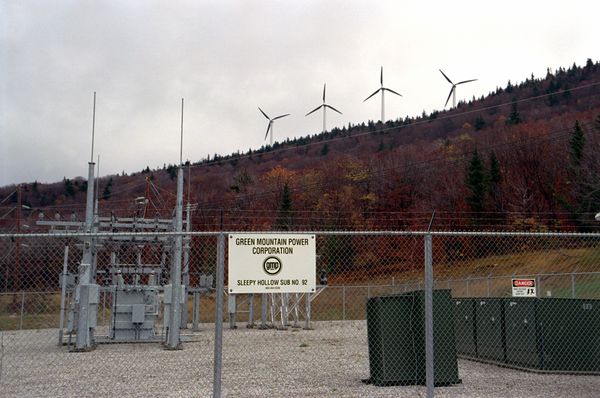
Some large community wind projects will be required to use substations as a part of the interconnection infrastructure. Photo by David Parsons, NREL 06791.
Interconnection processes differ depending on the project size and the utility, so it is important to begin researching and planning early. All costs associated with the required interconnection studies are the responsibility of the project developer and not the local utility.[29] Costs associated with equipment upgrades needed to interconnect a project depend on whether the project is interconnected through the transmission system or to a local distribution network. Upgrades associated with projects that are interconnected through the high-voltage distribution system can typically receive transmission credits for network upgrades. Distribution network-connected projects do not typically qualify for this credit.[30] A knowledgeable team member or consultant must fully understand the study results and be able to assist in negotiating system upgrade responsibilities.
Often systems below a certain size have simpler rules for interconnection, so understanding the utility's regulations is crucial. It can also help determine the interconnection costs and how they will affect the overall project economics.[29]
One- or two-turbine projects can connect at a distribution-level voltage (12.5 to 41 kV, if one is nearby), which generally means the project will not be required to construct a new substation. In this situation, a large community wind project will need the necessary equipment to "step up" the voltage level at the base of the turbine prior to connecting to the distribution-level voltage line. This typically includes a step-up transformer and other appropriately sized collection system components.
If a project is required to interconnect to the transmission system, it will be necessary to construct a substation, which can easily add $1 million to $5 million or more to the total project cost. A substation is a facility that contains equipment utilized to switch, change, or regulate electric voltage.[31] They also regulate the flow of electricity, with breakers as an example, and act as a safety device to protect the project and the grid from the impacts of faults. Substations are also where revenue grade meters are installed to determine financial compensation.
It is important to note that projects in excess of 10 MW will probably have to connect to higher-voltage (above 69 kV) lines because they require more electrical capacity than distribution voltage lines can provide.[32]
If you are interconnecting to a power line owned by a utility that participates as a Regional Transmission Organization (RTO) or is managed by an Independent System Operator (ISO), you must complete steps such as:
- Interconnection application
- Interconnection feasibility study
- System impact study
- Facility study
- Optional study
- Large generator interconnection agreement.[32]
Interconnection applications can be found on a utility's website and may require additional fees. In most cases, the "fee" is considered an estimated cost of the study (paid up-front by the developer), but note that an additional invoice could be forthcoming if the study costs exceed this estimate. Information needed to complete an interconnection request includes:
- Project location
- Proof of land control at the point of interconnection (e.g., copy of signed land lease) and sometimes proof of land control for turbines
- Estimated in-service date
- Network resource or energy resource
- Type of generator and specifications (manufacturer, model name, number, and version)
- Total number of generators
- Project size/capacity (MW)
- Power system load-flow data sheet
- One-line facility and point of interconnection diagram
- Transformer specifications.[29]
The initial interconnection feasibility study provides a high-level analysis of whether a project is viable at a point of entry into the grid. The feasibility study also examines how the proposed facility will interact with other facilities that are currently, or will soon be, connected to the grid.[33] Negative impacts that can be revealed from an interconnection feasibility study include circuit breaker faults, thermal overloads, or voltage-limit violations.[29]
The feasibility study will also require a cost estimate that will take into account the generator type, size, and potential impacts based on interconnection standards and criteria.[32] The project could be responsible to pay for upgrades necessary to maintain the safe and reliable operation of the grid. If the feasibility study reveals no negative impacts, the utility may provide an interconnection agreement without requiring any additional steps.[29]
System impact studies further detail electric system impacts from the proposed project, including how it may affect reliability. A detailed system impact study can consist of analyses of potential effects including power flow, short-circuit conditions, voltage drop and flicker, protection and control coordination, and grounding. Results of the system impact study will include an introductory indication of the cost and amount of time that would be required to repair any identified issues.[34]
The final step before an interconnection agreement can be completed is the interconnection facilities study. The interconnection facilities study identifies the necessary equipment, engineering, procurement, and construction work to connect the large community wind project to the grid. The study will include all necessary equipment, estimates of the full interconnection cost, and the time required to complete the construction.[33]
Optional studies can be conducted to determine what impacts, additional system costs, and potential benefits will result from alternate system configurations. Like the other studies, optional studies will involve an initial meeting and a financial deposit for the study. Costs and payment schedule will depend on the extent and estimated costs of conducting the study.[32]
The interconnection agreement is the last step required prior to installing your turbine and officially interconnecting to the local utility's distribution line. The agreement finalizes payment details for the necessary system upgrades that were noted in the previous interconnection studies and may include operations and maintenance fees.[29]
Completion of all interconnection studies and signing the large generator interconnection agreement only gives you the right to interconnect, not to transmit electrons. Projects may have to go through a transmission service process if the development connects to one utility's line but sells the power to a different utility. In this scenario, it is important to understand which party (buyer or seller) is responsible for obtaining necessary transmission rights.[35]
Secure Power Purchase Agreements
Total project cost and the strength of the wind resource will dictate the power purchase agreement (PPA) price ($/megawatt-hour) that will be needed to ensure project profitability. PPAs are contracts between energy producers (such as large community wind farms) and buyers (utilities or other large consumers) that specify transaction details, including the amount of electricity to be delivered and the price that will be paid for the energy produced. The term is usually between 15 and 25 years.[36]
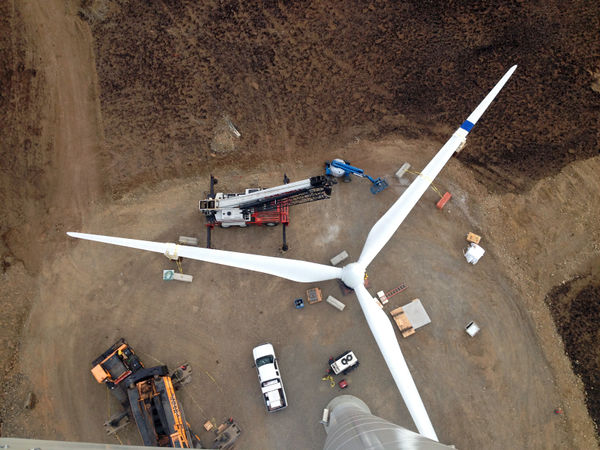
Turbines at Swauk Creek Ranch generate community-scale power. Photo from McKinstry, NREL 26781.
There are multiple ways to secure a PPA, including:
- Competitive solicitations offered from:
- Utilities power buyers
- Standard RFP process (bidder's experience and price are evaluated)
- Auctions (occurs after bidders have been qualified. Price is the determining factor)[37]
- Non-utility buyers/power off-takers (example: Amazon and Google)
- Private negotiations (a.k.a. bilateral contracting)
- Utility power buyers
- Non-utility buyers/power off-takers
- Feed-in-tariffs
- PURPA contracting (securing a qualifying PPA contract with a utility at the utility's avoided cost)[38]
- Merchant sales (selling the project's output on the open market)
Other details that are often included in a PPA are curtailment agreements, transmission specifics, schedule milestones, delay damages, insurance, and environmental attributes or credits.[36]
Understand Ordinances, Zoning, and Permitting
Officials or other local parties may pose questions while you navigate the permitting and zoning process for a large community wind project. Questions can pertain to project design, environmental impacts, natural and cultural resource impacts, setbacks, sound requirements, and overall aesthetics. It is important to be prepared early in the development of your project to address concerns.
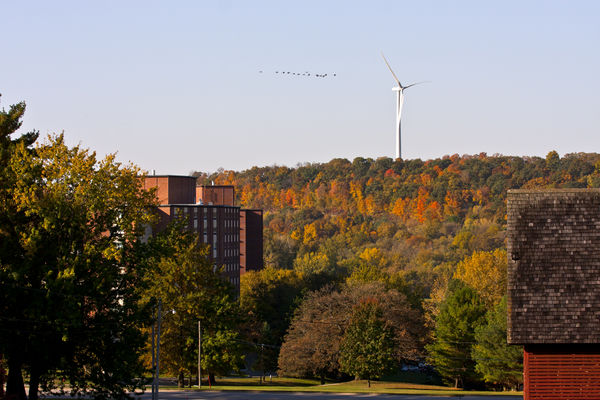
A thorough understanding of local regulations can help ensure project success. Photo from Luther College, NREL 26493.
Having an initial project design prior to beginning the permitting and zoning process will allow you to address potential concerns. The initial project design should include the locations of the proposed turbines and any associated equipment and the surrounding landscape, to include natural features and man-made structures.[39] To further understand state and local (county and township) wind energy regulations, you should recognize the differences among ordinances, zoning, and permitting.
Ordinances
Ordinances are legal requirements enacted by a municipal government (like a city council), often found within municipal codes. Ordinances cover issues such as zoning, traffic, consumer protection, and building codes. A wind energy ordinance reflects local preferences regarding wind turbines within county or city limits and aids the development of safe facilities.[40] Wind energy ordinances can set the requirements of a permit application, define the necessity and process for public hearings, and provide guidance essential to the subsequent approval or denial of your project's permit application. Unless the established ordinances are particularly restrictive, it may be easier to install a project in a jurisdiction that has an ordinance as opposed to a location with no rules or general knowledge regarding wind energy.
Other components of wind energy ordinances can include regulations for setbacks, sound, and shadow flicker.
Setbacks are standards defined to create space between areas of concern and the wind project. Common areas of concern include property lines, inhabited structures, public roads, as well as communication and electrical lines.[41] Regulations for setbacks differ depending on the project location.[39] Setbacks can be based on tower, hub, or tip height; rotor diameter; or some combination of the above. For example, setbacks from homes in international locations vary widely; in a U.S. example, they are defined as four times the tower height in Woodford County, Illinois.[42][43]
Sound requirements create a standard maximum level of allowed sound due to the operation of wind systems. These standards often include a defined method of measuring sound level.[41] To alleviate sound concerns related to a large community wind project, the issue should be addressed early in the development process with nearby neighbors and at community meetings, allowing for positive community involvement in this area. Planning and siting are critical to minimizing noise impacts on host communities.[44]
An additional concern regarding the siting of a large community wind project is the potential impact from shadow flicker. Shadow flicker occurs when turbine blades cast shadows across the ground or buildings when the sun is low on the horizon. It can be prevented, or at least minimized by utilizing proper setbacks. Some jurisdictions regulate the number of hours per year, or minutes/hours per day, that a particular window can experience shadow flicker.[45]
If you are installing a large community wind project in a location without a wind ordinance, it's possible that the local government will want to establish one prior to approving your installation. Model wind energy ordinances are available, and they can serve as guidelines for communities planning to establish a wind ordinance.[46] When researching and obtaining other county ordinances to be used for the creation of a new ordinance, it can be helpful to ask if any projects have been built under this sample ordinance. Some counties pass a wind ordinance that is so restrictive that no projects can be built; it essentially functions as a moratorium. As community planning and zoning authorities attempt to regulate safe and responsible projects, it is important to know the results of existing ordinances that are being used to develop local regulations.
Zoning
Zoning is "a system of land use regulation that controls the physical development of land. It is a legal mechanism by which local government is able to regulate an owner's right to use privately owned land for the sake of protecting the public health, safety, and/or general welfare."[47] Zoning controls actions in certain land-use areas, including whether an individual can install a wind turbine in a particular location after obtaining the proper permits required by local authorities. Some jurisdictions have defined specific zones (Wind Energy Overlay Districts, Renewable Energy Zones) which limit wind energy development to certain parts of the town/county where the overall impact will be minimal or in some cases to where the wind resource is best.[41]
Permitting
Permitting is a process established by local authorities to control development, in this case how a wind turbine is installed, located, operated, and decommissioned. Permits are usually granted in accordance with the provisions of the ordinance regulating the development of wind systems.[41] Contact your local authorities to learn the type of permitting needed for your project, the associated costs, and whether any previously granted permits are available for review.
Most jurisdictions with established wind ordinances allow turbines to be installed through permitted use, accessory use, or through a conditional use permit. The time required to acquire permits for a large community wind project can vary depending on the overall size of the project, whether the project is in a local or state jurisdiction, the established permitting process, results of pre-construction studies and surveys, as well as the community view of the project and other considerations.[39]
It is essential to begin the permitting process early to understand the necessary steps required prior to investing time or money. It is highly recommended that a local attorney is engaged to assist in researching a complete list of permitting requirements and guide the project through the various processes.
Any project with a structure taller than 200 feet, or one planned near airports or other aviation facilities, will require Federal Aviation Administration (FAA) permitting.[48] A related issue is potential interference with military long-range radar, NEXRAD, or military operations. The FAA offers a Department of Defense preliminary screening tool that allows developers to acquire a preliminary review of potential radar related impacts to prior to an official filing.
It may be necessary to conduct an environmental (wildlife and historical/cultural) study to acquire any required environmental permits and to accurately inform local officials and the surrounding community of the potential impacts a wind project could have on surrounding wildlife and other environmental concerns. Properly gauging the impact on wildlife and the environment requires local expertise, including state fish and game agencies, federal wildlife agencies, wildlife or environmental experts from local universities, and other knowledgeable parties such as the state historical and preservation office. These organizations and individuals may help you save time and gather valuable information pertaining to the site-specific wind and wildlife impact and historical impact from your large community wind project. It should be noted that environmental concerns are dependent on the types of plants and animals present at a specific site, as well as the design of the wind project.[49]
During the permitting and zoning process, concerns regarding natural and cultural impacts could be expressed. Speaking with the state historical preservation office or consulting the National Register of Historic Places can help you understand the potential cultural impacts associated with a location, whether a more in-depth study should be conducted, as well as what to do if any artifacts are encountered during construction.[50]
Project aesthetics play an integral role in how an installation will be received by the local public. Signage, lighting, and the location of additional infrastructure can impact a community's perception of a wind project. To ease concerns, project developers should provide a visual representation of the proposed installation to show what the large community wind project will look like after construction is completed.[50]
Larger turbine components require special transportation and support vehicles and can only be transported on certain U.S. highways. Wind turbine blades longer than 53 m present a transportation obstacle due to the large turning radius, which hinders right of way or encroachment areas within corners or curves on roads and railways. Each state along a transportation route has different permit requirements.[51]
Once parts for the project begin to arrive, it might be necessary to have a designated temporary staging area. This space will be used to store components until they are needed for construction and can also be used to house construction management facilities.
A building permit or electrical permit[52] and driveway permit[53] may also be required for the project, which could add additional costs and time.
Another issue that may be raised during the permitting process is the decommissioning of the project once it has exceeded its working lifetime. The decommissioning of a project should be considered from the planning process and should include the dismantling of the turbine and the restoration of the site. Some communities may stipulate that a project provide a bond or letter of credit that would cover the cost of decommissioning.[54]
Select and Procure a Turbine
Turbine selection and procurement rely on multiple project-specific factors, turbine availability, and whether manufacturers are willing to provide turbines for smaller projects.
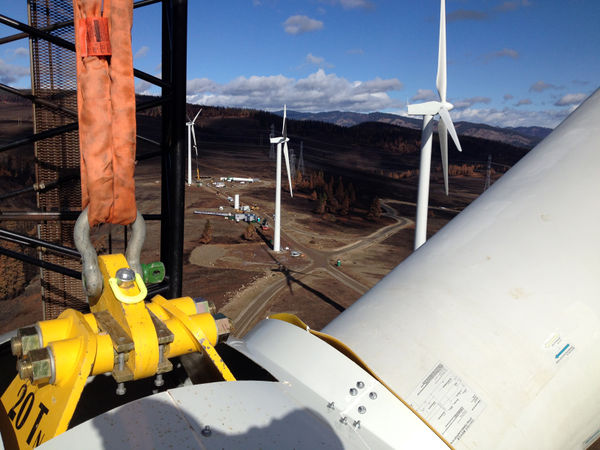
A variety of factors will influence turbine selection. Photo from McKinstry, NREL 26779.
Certain sites will require turbines with longer blades or higher towers to function properly with the consistent but low average wind speed at that location. Other sites will require turbines that are designed to function in cold-weather regions.[55] To better understand the type of turbine(s) that will be required for your large community wind project, it is important to understand the characteristics of your site, including the wind resource. Understanding how the site's characteristics will impact a project's performance and lifespan prior to finalizing your turbine selection is a vital step in the development process.
Turbine selection can also be influenced by how a project plans to interconnect into the distribution system. If developers are looking to minimize the cost for potential upgrades in order to interconnect, they may choose to develop a smaller wind project.
Selection will also be influenced by the proximity of operations and maintenance (O&M) teams in your area. The cost of O&M impacts the final project price, so it is important to choose a model turbine that O&M teams within a close proximity are qualified to work on. This can help to reduce the cost of travel and improve the availability of O&M teams for unscheduled maintenance situations.[56]
Most turbine manufacturers will require a deposit and a letter of credit for the remaining cost prior to accepting an order. The time between placing your deposit and turbine delivery can be more than a year, depending on the number of orders in the queue.[57]
Also note that many manufacturers choose to provide turbines for large commercial wind projects instead of smaller developments.[58] All of these factors combined can lead to project developers having to select a second or third choice of turbine for a large community wind project.
Understand the Construction Process
The scope and scale of a large community wind project dictates that you should hire a qualified party with previous wind turbine installation experience to coordinate and conduct the construction portion of your project. Project developers can also utilize turbine vendors who may be willing to install the project.[59]
Though the construction process can vary, it typically involves multiple steps that can include site preparation, running and trenching of cable, foundation engineering and construction, electrical upgrades for interconnection, tower erection, nacelle and hub attachment, blade assembly and attachment, and site restoration.
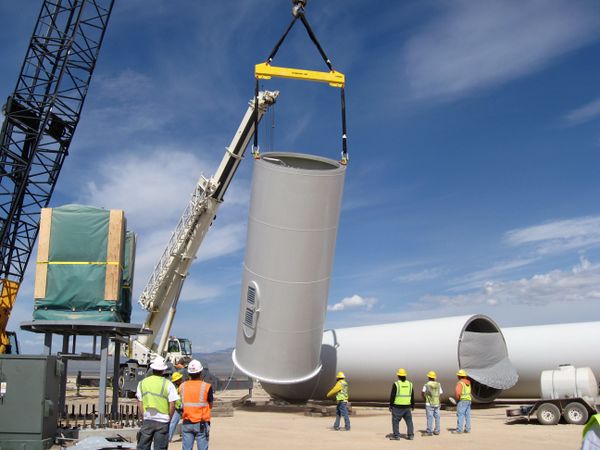
The construction process for a large community wind project requires the hiring of experienced installers. Photo from First Wind, NREL 16737.
Site preparation for large community wind projects will most likely start with the development of access roads to move components and provide routes for the heavy equipment necessary for the installation.
Site grading may be required to provide a level surface for cranes. In addition to this, grading may be needed for a temporary storage area prior to the delivery of turbine parts and components.
To connect turbines to transformers and transformers to the interconnection point, cables must be laid underground or installed aboveground. The decision on how cables are installed should be made during the permitting process and should be based on cost, land-use and wildlife impacts, and maintenance requirements. Additional electrical work may be needed to complete the installation. This will include any upgrades required in the interconnection agreement.
The type and size of turbine, along with the individual site, will dictate foundation specifications. Engineering will be required during foundation design and construction. Foundations may require between eight and 20 truckloads of concrete per foundation to complete.[60] Multiple foundation types have been used in wind projects.
Wind turbine towers for large community wind projects are typically sectioned and must be assembled utilizing a crane. Successful tower assembly and construction allow the remaining components to be attached.
Following tower assembly and construction, the turbine's nacelle is lifted and attached. The nacelle is the home of multiple components including the drive shaft, gearbox, generator, electronic controls, and other associated equipment.
Once the nacelle has been added to the project, the turbine's hub is lifted and attached. The hub is the main component between a turbine's nacelle and blade assembly. Once it has been installed, turbine blades are assembled, lifted, and fastened to the hub.
Once construction is complete, the surrounding land should be restored to its original condition.[59]
Videos are available that depict the construction process. One example of the construction process is Case Western Reserve University's Wind Turbine Time Lapse Installation Video.
Understand Operations and Maintenance
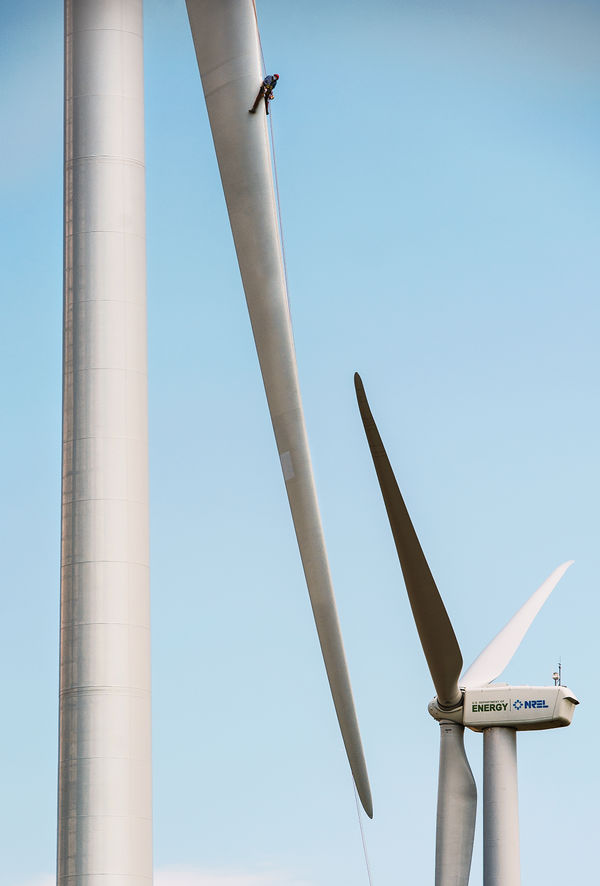
The operation and maintenance of a large community wind project requires a variety of tasks including blade inspection. Photo by Dennis Schroeder, NREL 27202.
Industry-recommended best practices exist for all aspects of wind turbine maintenance and can help ensure an extended life for the project.[61]
Some turbine vendors provide O&M services during the initial 2- to 5-year warranty period. Once the warranty has expired, or if one is not offered, it is necessary to hire an O&M team to conduct routine scheduled O&M tasks.[62] Turbine vendors, manufacturers, and third-party businesses offer turbine O&M services, which can range from $20,000 to $50,000 per year per turbine.[63]
If your large community wind project is located near a commercial project that utilizes the same type of turbine model, it may be possible to hire the commercial project's O&M team rather than hiring a team dedicated to your project.[64]
An important part of O&M is ongoing turbine monitoring. Suggested staffing numbers for a large community wind project will depend on the size of the facility, but it has been suggested that one technician be hired for every six to eight turbines installed.[61]
Learn about Project Economics and Tools
The overall economics of a large community wind project include resource assessment and site analysis costs; the purchase and transportation of the turbine and tower; project construction; permitting and interconnection fees and upgrades; additional equipment and metering components; insurance; operations, warranty, maintenance, and potential repairs; legal and consultation fees; and potential good neighbor payments. Windustry's Community Wind Toolbox, Chapter 8: Costs is dedicated to the various expenses associated with a project, including estimates for most of the project details listed above.[65]
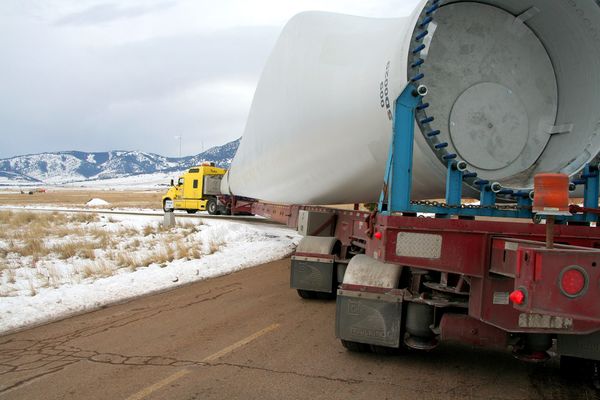
Component transportation is one of many costs that should be considered while calculating project economics. Photo by Jim Green, NREL 16178.
One economic factor that can be overlooked involves property tax implications. Property tax impacts due to the installation of a large community wind project will depend on the state and county where the project is located. Some states offer temporary tax exemptions or allow projects to be assessed at a different value for a limited period.[66] Contact your state or county's division of property taxation to determine the impact that the property's assessed value will have on property taxes. Project developers usually agree to pay all increases in property taxes when facilities are sited on lands owned by others and leased to the project so the landowner is made whole if his or her farm property tax bill increases due to hosting turbines.
Calculating the payback for your project and determining the internal rate of return (IRR) during the development process are essential in determining a project's economic potential. The payback period is the amount of time needed for the project to pay for itself through the energy it has produced. If the project economics do not equal a favorable payback period, some details may have to be revisited.
The IRR compares the current value of a project's expected revenues with the current value of its expected costs and is often used by utilities or businesses in assessing investments as a measure of profitability. A higher IRR tends to lead to a better economic potential for the wind energy system.[67]
Multiple tools are available to help determine the IRR and payback period for a project. You will have to utilize some of the previously gathered information to calculate the payback for your large community wind project.
The System Advisor Model (SAM) is a performance and financial tool designed to facilitate decision-making for people involved in the renewable energy industry, ranging from project managers and engineers to incentive program designers, technology developers, and researchers. Its cash flow models are appropriate for distributed energy projects that buy and sell electricity at retail rates and for power generation projects that sell power at a price negotiated through a power purchase agreement. The model calculates the cost of generating electricity based on information provided about a project's location, installation and operating costs, type of financing, applicable tax credits and incentives, and system specifications.
Outputs from SAM include:
- Levelized cost of energy
- Power purchase price, internal rate of return, and other financial targets for utility-scale projects
- Payback period and net present value for residential and commercial projects
- Hourly, monthly, and annual average predictions of system performance, including net electric output and component efficiencies
- Annual cash flow table with cost details
- Customizable graphs.[68]
An additional tool that can be used to help calculate project financing and economics is Windustry's Wind Project Calculator. Developed to assist in conducting cash flow modeling for community wind projects, the Wind Project Calculator requires detailed information about the prospective turbine model, estimated annual average wind speed, electricity use and rates, and financing and income taxes. The program is designed to estimate cash flows for wind turbine investment and the rate of return on investments.
The National Renewable Energy Laboratory's (NREL) Jobs and Economic Development Impact (JEDI) model assists in estimating the economic impacts of constructing and operating power plants, fuel production facilities, and other projects at the local (usually state) level. JEDI results are intended to be estimates, not precise predictions. Based on user-entered project-specific data or default inputs (derived from industry norms), the JEDI Wind Model estimates the number of jobs and economic impacts to a local area that can reasonably be supported by a power plant, fuel production facility, or other project. For example, JEDI estimates the number of in-state construction jobs from a new wind farm. Jobs, earnings, and output are distributed across three categories:
- Project Development and Onsite Labor Impacts
- Local Revenue and Supply Chain Impacts
- Induced Impacts.
JEDI model defaults are based on interviews with industry experts and project developers. Economic multipliers contained within the model are derived from Minnesota IMPLAN Group's IMPLAN accounting software and state data files.
More Information
- Bolinger, M. (2011). Community Wind: Once Again Pushing the Envelope of Project Finance. Lawrence Berkeley National Laboratory.
This report describes innovative new financing structures for community wind projects, using case studies. - Clean Energy States Alliance. (2010). State-Based Financing Tools to Support Distributed and Community Wind Projects.
This guide reviews the financing role that states, and specifically state energy funds, have played and can play in supporting community and distributed wind projects. - Lantz, E.; Tegen, S. (2009). Economic Development Impacts of Community Wind Projects: A Review and Empirical Evaluation. National Renewable Energy Laboratory.
This report provides a review of previous economic development analyses of community wind projects and compares these projected results with empirical impacts from projects currently in operation.
Research Financing Options
Due to the substantial costs involved with a large community wind project, most installations involve a variety of investors or a unique financing model to provide funding. Local lenders are considered to be one of the best sources of debt financing for large community wind projects. When beginning discussions, it is important to be prepared with materials to support your project. Lenders want to see a detailed project summary with cost estimates and a legal description of the proposed project site, including aerial photos and plat drawings if possible. You also will need detailed project expenses and income (monthly for at least 24 months and annually for 10 to 20 years).[69]
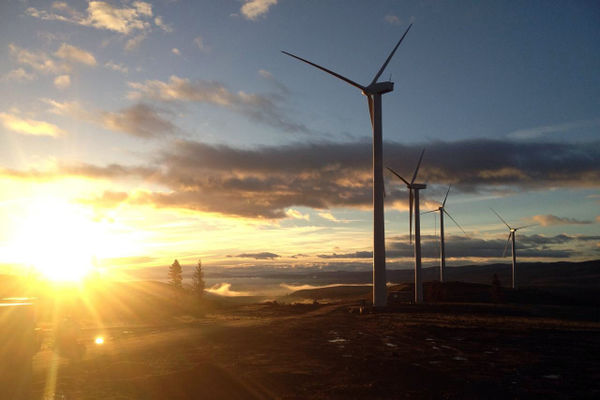
Since large community wind projects have budgets that exceed $2 million developers may seek investors or unique financing models. Photo from McKinstry, NREL 26777.
Lenders may also ask for:
- Wind assessment
- Project feasibility study
- Proof of required easements
- Proven ability to manage a wind project
- Zoning and permitting approvals
- Turbine type and performance data
- Warranties and O&M agreements
- Decommissioning plan
- Interconnection studies and an executed large generator interconnection agreement
- Power purchase agreement (executed)
- Insurance details
- Business, financial, and risk management plans.
Many lenders have requirements of a minimum equity payment of 30% of the total project costs. The term note is usually amortized over 10 or more years with quarterly or yearly payments. The loan interest rate is vital as it is capable of determining the difference between a project that makes a profit and one that simply breaks even.[69]
To ensure a shorter payback period for your large community wind project, research grants and other available funding sources.
Know the Effects of Policies and Incentives
Policies and incentives are important drivers in lowering the cost of a large community wind project. As mentioned earlier, in 2021, the capacity-weighted average installed project cost within a sample of projects was $1,500/kW.[7]
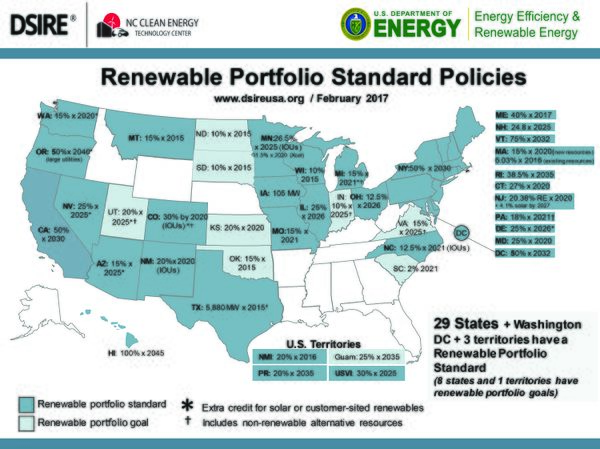
The Database of State Incentives for Renewables and Efficiency's Renewable Portfolio Standards summary map is updated quarterly to reflect current RPS policies in the United States.
Many states provide tax incentives that large community wind projects can qualify for, including a corporate income tax credit, property tax abatements or exemptions, sales tax exemptions, or a performance incentive similar to the PTC.[71] The Database of State Incentives for Renewables & Efficiency (DSIRE) contains summaries of state incentives.
Many states have begun to require the purchase of wind energy in the form of a mandate often referred to as a renewable portfolio standard (RPS).
State RPS policies are considered to be one of the primary drivers of renewable energy capacity in the United States. However, some states have exceeded requirements and utilities have added new electric generation capacity, primarily in the form of wind energy, due to its low cost compared to traditional alternatives.[71]
References
- Rynne, S.; et al. American Planning Association. Planning for Wind Energy.
- Lantz, E.; Tegen, S. National Renewable Energy Laboratory. Economic Development Impacts of Community Wind Projects: A Review and Empirical Evaluation.
- Jones, C.; Eiser, R. Identifying Predictors of Attitudes Towards Local Onshore Development with Reference to an English Case Study.
- Zoellner, J.; Schweizer-Ries, P.; Wemheuer, C. Public Acceptance of Renewable Energies: Results from Case Studies in Germany.
- McLaren Loring, J. Wind Energy Planning in England, Wales and Denmark: Factors Influencing Project Success.
- Devine-Wright, P. Beyond NIMBYism: Towards an Integrated Framework for Understanding Public Perceptions of Wind Energy.
- U.S. Department of Energy. Land-Based Wind Market Report: 2022 Edition.
- National Renewable Energy Laboratory. A Framework for Project Development in the Renewable Energy Sector
- Canadian Wind Energy Association. Wind Energy Development: Best Practices for Indigenous and Public Engagement
- Superior Watershed Partnership. Community Wind Power: A Guide for Upper Peninsula Communities
- U.K. Department of Energy and Climate Change. Community Engagement and Benefits from Onshore Wind Developments: Good Practice Guidance for England
- National Renewable Energy Laboratory. A Framework for Project Development in the Renewable Energy Sector
- Rural Minnesota Energy Board. Community Wind Development Handbook
- Renewable Energy Alaska Project. Wind
- Manwell, J. et al. Wind Energy Explained: Theory, Design, and Application
- Hilario, C. Wind Turbine Inspection, a Strategic Service?
- Farmers' Legal Action Group, Inc. Negotiating Wind Energy Property Agreements
- Stoel Rives LLP. The Law of Wind: A Guide to Business and Legal Issues
- Energy Trust of Oregon. Community Wind: An Oregon Guidebook
- Lawrence Berkeley National Laboratory. The Cost of Transmission for Wind Energy: A Review of Transmission Planning Studies
- altenergymag. In Support of Wind Energy: The Foundations that Underlie Wind Projects
- New York State Energy Research Development Authority. Wind Resource Assessment Handbook
- National Renewable Energy Laboratory. A Framework for Project Development in the Renewable Energy Sector
- New York State Energy Research Development Authority. Wind Resource Assessment Handbook
- New York State Energy Research Development Authority. Wind Resource Assessment Handbook
- Energy Trust of Oregon. Community Wind: An Oregon Guidebook
- Germanischer Lloyd Renewables Consulting & Engineering. The Impact of Site Conditions on the Turbine Suitability
- Renewable Energy Research Laboratory, University of Massachusetts, Amherst. Uncertainty Analysis in Wind Resource Assessment and Wind Energy Production Estimation
- Energy Trust of Oregon. Community Wind: An Oregon Guidebook
- PacifiCorp. Generation Interconnection Process
- U.S. Energy Information Administration. Electricity Glossary
- Windustry. Interconnection: Getting Energy to Market
- National Renewable Energy Laboratory. Generation Interconnection Policies and Wind Power: A Discussion of Issues, Problems, and Potential Solutions
- National Renewable Energy Laboratory. System Impacts from Interconnection of Distributed Resources: Current Status and Identification of Needs for Further Development
- Farmers' Legal Action Group. Farmers' Guide to Wind Energy
- Stoel Rives LLP. The Law of Wind: A Guide to Business and Legal Issues
- National Renewable Energy Laboratory. Procurement Options for New Renewable Electricity Supply
- Law360. Understanding PURPA Rights In Power Purchase Agreements
- Energy Trust of Oregon. Community Wind: An Oregon Guidebook
- U.S. Department of Energy. Wind Energy Ordinances
- Oteri, F. An Overview of Existing Wind Energy Ordinances
- Minnesota Department of Commerce. Energy Facility Permitting
- Woodford County Government. Zoning Ordinance
- Rynne, S.; et al. American Planning Association. Planning for Wind Energy.
- Lampeter, R. Shadow Flicker Regulations and Guidance: New England and Beyond
- Rynne, S.; et al. American Planning Association. Planning for Wind Energy.
- Baltimore County Government. What Is Zoning?
- Idaho Department of Water Resources. Permitting of Small and Medium Sized Wind Turbine Projects in Idaho
- National Wind Coordinating Committee. Permitting of Wind Energy Facilities
- Windustry. Community Wind Toolbox, Chapter 5: Siting Guidelines
- U.S. Department of Energy. Enabling Wind Power Nationwide
- Corpus Christi, Texas. Wind Energy Unit Information Packet
- Town of Green Bay, Wisconsin. Wind Energy System Zoning Ordinance
- Great Lakes Wind Collaborative. Best Practices for Sustainable Wind Energy Development in the Great Lakes Region
- Government of Canada. Wind Energy in Cold Climates
- Windustry. Community Wind Toolbox: Chapter 15, Turbine Selection and Purchase
- Energy Trust of Oregon. Community Wind: An Oregon Guidebook
- Farmers' Legal Action Group. Farmers' Guide to Wind Energy
- Energy Trust of Oregon. Community Wind: An Oregon Guidebook
- Windustry. Community Wind Toolbox, Chapter 8: Costs
- U.S. Department of Energy. Wind O&M.
- University of Southern Maine. A Maine Guide for Developing Community Wind Projects
- Windustry. Community Wind Toolbox, Chapter 8: Costs
- Energy Trust of Oregon. Community Wind: An Oregon Guidebook
- Windustry. Community Wind Toolbox, Chapter 8: Costs
- Farmers' Legal Action Group. Farmers' Guide to Wind Energy, Chapter 13: Legal Issues in Farming the Wind
- Windustry. Internal Rate of Return (IRR)
- OpenEI. System Advisor Model (SAM)
- Windustry. Community Wind Toolbox, Chapter 9: Financing
- U.S. Department of Energy. 2016 Wind Technologies Market Report
- Rynne, S.; et al. American Planning Association. Planning for Wind Energy.